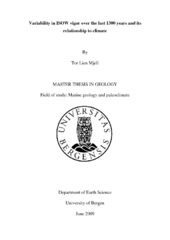| dc.description.abstract | Resolving the scale and origins of recent low frequency (decadal-centennial) climate variations, such as the AMO, is crucial for predicting how natural variability and anthropogenic forcing will interact to affect future climate evolution. These multi-decadal to centennial variations are often postulated to involve, or even be driven by, changes in the Atlantic Meridional Overturning Circulation (AMOC). Assessing this hypothesis for events such as the Little Ice Age (LIA) and the Atlantic Multidecadal Oscillation (AMO) requires records capable of depicting multidecadal changes in past ocean circulation. Here we use well dated (210Pb and AMS 14C), high sedimentation rate, multi and gravity cores taken on the Gardar Sediment Drift (60°19N, 23°58W, 2081 m water depth) to reconstruct decadal to centennial variability in the properties and vigor of the eastern branch of the Nordic Seas overflows over the past millennium. The Gardar drift accumulates on the eastern flank of the Reykjanes ridge due the supply of sediments provided by the overlying Iceland Scotland Overflow Water (ISOW) an important component of NADW. We reconstruct the bottom water physical and chemical properties of ISOW using the oxygen and carbon isotopes of benthic foraminifera (C. wuellerstorfi), while changes in the vigor of near bottom flow are inferred from size variations in the sediment mean sortable silt (¯( SS) ). The data produced to date provide a sub-decadally sampled history of ISOW variability spanning the last ~1300 years. In addition, changes in surface hydrography are reconstructed using δ18O of the planktonic foraminifer species G. bulloides, N. pachyderma (d), and G. inflata. This study provides the first evidence that AMOC variability is tightly coupled to low frequency variations in basin-wide climate (AMO). Our results show multi-decadal and centennial variability in ISOW vigor throughout the past ~1300 years. During the past ~350 years ISOW vigor is in phase with reconstructed AMO on both inter-decadal and centennial timescales with increased (decreased) ISOW vigor during warm (cold) AMO phases. This strong coherence suggests that low frequency variability in key components of AMOC is tightly coupled to basin wide temperature perturbations. However, our reconstructions of local near surface hydrography are out of phase with both the ISOW vigor and basin scale temperature pattern (AMO). This we attribute to variations in the dynamics of the Atlantic subpolar gyre rather than basin-wide climate, possibly related to NAO forcing. | en_US |
